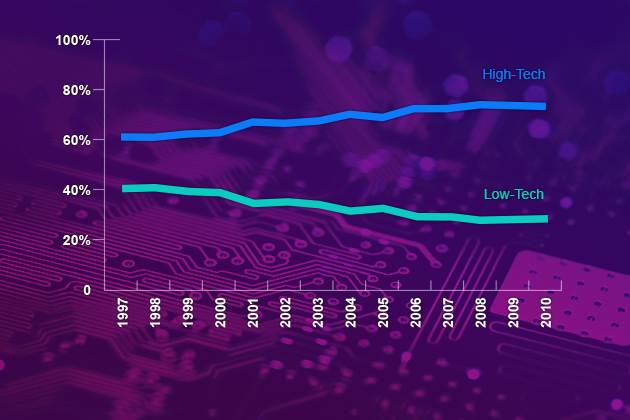
After decades of shedding factory jobs, manufacturing may seem just a vestige of Connecticut’s economic past. Yet in the Winter 2013 issue of The Connecticut Economy released today, UConn economist Steven Lanza issues a “report card” on manufacturing that presents the sector as among the most dynamic in the state’s economy, transformed by advanced technologies linked to research and development that are providing a catalyst for economic growth.
The resurgence of high-precision, highly skilled, and high-paying manufacturing employment reflects the “churn,” or the process of firms appearing and disappearing as innovation spurs rapid changes to Connecticut’s manufacturing profile, says Lanza, executive editor of The Connecticut Economy, a quarterly journal published by UConn’s Department of Economics. It also means, he adds, that the largely production-line jobs of the past aren’t coming back.
“The factory floor isn’t the noisy, grimy crucible it once was,” he observes. “Manufacturing has become increasingly technologically advanced, requiring sophisticated machines and computers operated by highly trained and skilled workers.”
Declining numbers, increased productivity
Factory jobs in Connecticut slumped from 477,000 in 1969 – accounting for about one-third of total employment in the state – to just 174,000, about 10 percent of jobs statewide, in 2011, according to U.S. Bureau of Economic Analysis data. Yet the sector’s decline has stabilized, Lanza claims, noting that job tallies for the past two years show Connecticut manufacturing employment remaining steady at about 165,000 workers.
Despite the years of job declines, however, manufacturing always made outsized contributions to Connecticut’s gross state product. The sector contributed 20 percent of the growth in the state’s economic output in the decade ending in 2010, Lanza estimates, while boosting productivity – the value of manufactured goods per worker – by more than 50 percent from 1990 to 2007, with 35 percent fewer workers.
“Expanding output and falling employment [over that timeframe] combined to raise productivity per worker from $57,900 to $135,800, an impressive 134 percent increase,” Lanza says. Enhanced productivity, in turn, also led to higher wages: in 2011, Connecticut factory workers – who are now more likely to have a graduate degree and wear a suit or lab coat to work – earned an average salary of $76,900, or 26 percent above the state’s all-industry average of $61,100.
Connecticut’s manufacturing profile has also changed drastically; high-tech firms now produce more than 70 percent of the state’s output with computer/electronic products and chemicals accounting for more than 13 percent and 30 percent, respectively, of the total output in 2010. Lanza also details how the state is now a leader in the aerospace and defense-related transportation equipment field – largely in the production of aircraft engines, helicopters, and nuclear submarines – totaling 23 percent of the state’s manufacturing output in 2010, compared with 20 percent in 1997.
Unlike the sprawling smokestack factories of the past, the majority of today’s manufacturers are small and mid-sized, reflecting the vibrant competitive opportunities in the state. Sustained growth in the sector has witnessed the creation of 290 small enterprises annually – most with fewer than five workers – a “birth rate” of about 6 percent annually, says Lanza. However, death rates for smaller firms are higher too, at about 7.5 percent, he adds.
To better assess Connecticut’s manufacturing health, Lanza created an index to measure the sector’s performance against other states and discovered Nutmeg manufacturers rank sixth nationwide, behind Oregon, Indiana, Wisconsin, Massachusetts, and Louisiana.
“Connecticut owes its high [rank] to impressive scores in employee compensation and a concentration in technological sophistication,” says Lanza. “These attributes offer promise that the manufacturing industry will continue to be a cornerstone of the state’s economy in the 21st century.”
The Connecticut Economy is a quarterly journal published by the University of Connecticut’s Department of Economics that offers data, forecasts, and substantive, data-driven analyses of current events, longer-term trends, and public policies affecting Connecticut’s economy. The new Winter 2013 issue is available online at: http://cteconomy.uconn.edu/TCE_Issues/Winter_2013.pdf. To access the archives with past issues starting from 1993, please visit The Connecticut Economy website: http://cteconomy.uconn.edu/


